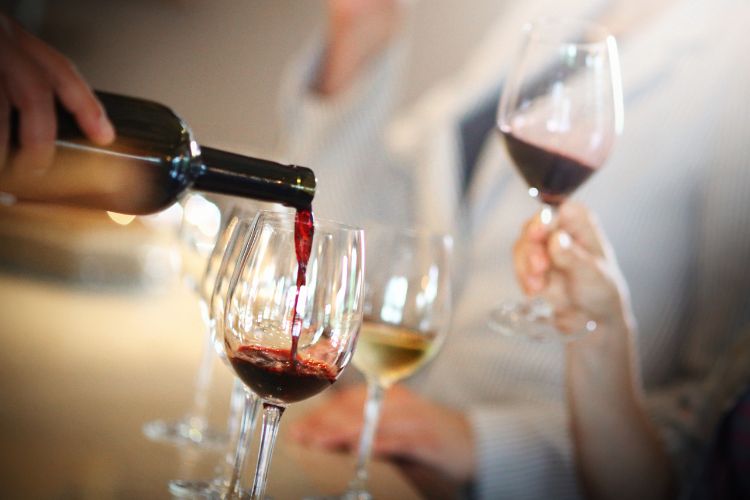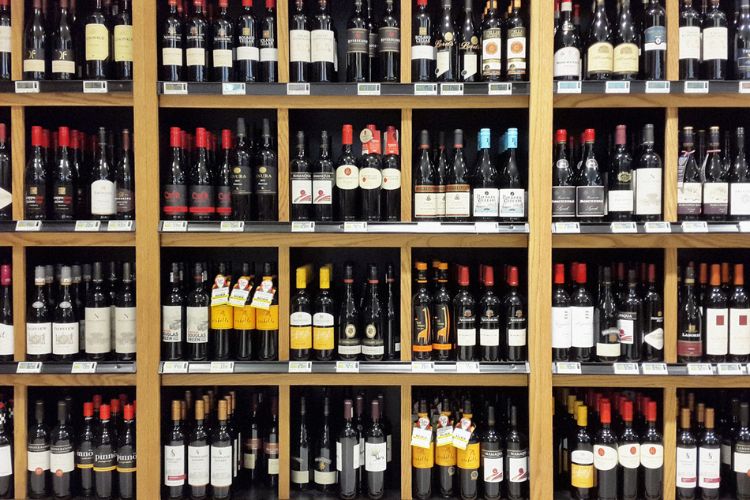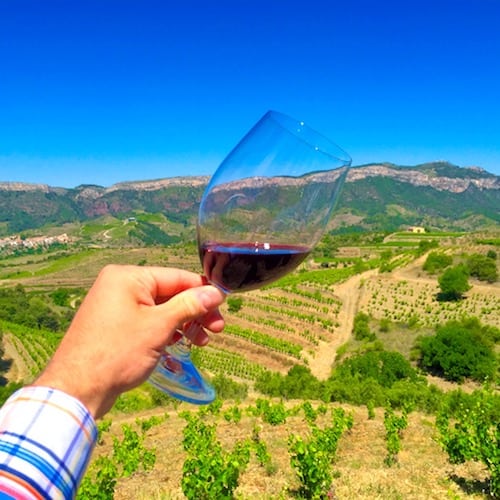Dry vs. Sweet Wine Explained
One of the first things a sommelier attempts to determine during a deductive wine tasting is the sweetness level of the wine he or she is drinking. At the most basic level of its classification, a wine is typically placed in either a dry or sweet category.
- Dry vs. Sweet Wine Explained
- Sweet vs. Dry Wine: What's the Difference?
- Common Factors that Make a Wine Sweet or Dry
- The Science Behind Sweetness and Dryness in Wine
- Popular Sweet and Dry Wines
- Pairing Sweet Wines with Food
- How to Read Wine Labels for Sweetness and Dryness
- Tips for Finding Your Preferred Level of Sweetness or Dryness
- Ask the Experts: Engaging with Sommeliers and Wine Merchants
- Challenging Your Palate: Experimenting with Sweet and Dry Wines
- Hosting a Sweet vs. Dry Wine Tasting Party
- Frequently Asked Questions about Dry vs. Sweet Wine
Sweet vs. Dry Wine: What’s the Difference?
Wines that retain a high amount of residual sugar following fermentation are classified as sweet wines.
Wines with low levels of residual sugar following fermentation fall into the dry category.
But is it really that easy to taste the difference between sweet and dry wine? There are a number of factors that affect the gradation of how sweet or dry a wine is – as well as our perception. For instance, a wine may taste sweet, but be classified as dry. In order to really grasp this concept, we need to move away from trusting what our taste buds perceive as sweet and try more to understand what goes into a wine that gives it its perceived flavor.
RELATED: Step-by-Step Guide to Tasting Wine Like a Sommelier
While winemakers around the world employ different methods to influence the residual sugar content of a wine, we’ll explore the most common strategies below.
Common Factors that Make a Wine Sweet or Dry
When Grapes are Harvested
Immature grapes have a lower sugar content than ripe (mature) grapes. Ripe grapes also contain lower levels of acidity than unripe grapes, which can influence flavor.
Vintners who are looking to create a dry wine will often pick their grapes before they are completely mature to attain a certain degree of acidity and lower levels of residual sugar following fermentation.
Terroir
Grapes grown in warmer climates tend to have a higher sugar content than those grown in cooler climates. The warmth from the sun enhances the concentration of sugar present in the water within the grapes.
What’s Done with the Grapes Following the Harvest
Winemakers looking to add sweetness to their wine will sometimes allow the grapes to dry in direct sunlight. This method intensifies the concentration of sugar present.
Conversely, winemakers in cooler climates can allow the grapes to remain on their vines until they’re frozen. When they’re eventually harvested, the water in the grapes will have a higher concentration of sugar. This results in a kind of wine commonly referred to as “ice wine.”
Fermentation
One of the most powerful ways to influence the sweetness or dryness of wine is to control the length of fermentation. Basic chemistry states that through a number of chemical processes, sugar is ultimately converted into alcohol. Sugars transition into carbon dioxide and ethyl alcohol during fermentation. The facilitator of this process is a micro-organism called Yeast.
The longer a wine is allowed to ferment, the dryer the end wine product will be.
RELATED: Food Pairing Concepts: This Food, That Wine
The Science Behind Sweetness and Dryness in Wine

The science behind sweetness and dryness in wine is deeply rooted in the chemical components found in the grapes and the transformations they undergo during the winemaking process.
The key component behind sweetness in wine is residual sugar. This sugar is naturally present in grapes and becomes the main source of energy for yeast during fermentation. As yeast consumes the sugar, it produces alcohol and carbon dioxide. The level of sweetness in a wine depends largely on when this fermentation process is halted. If fermentation is stopped before all the sugar is converted into alcohol, the remaining sugar—known as residual sugar—gives the wine its sweetness.
In contrast, if the yeast consumes nearly all the sugar, the result is a dry wine. Therefore, sugar and alcohol content in wine are inversely related—the higher the alcohol content, the dryer the wine, and vice versa.
Tannins and acidity, on the other hand, play a critical role in the perception of dryness. Tannins, natural compounds found in grape skins, seeds, and stems, contribute to the wine’s structure and mouthfeel. They create a sensation of dryness or astringency in the mouth, akin to the feeling after drinking a strong cup of black tea.
Tannins are more prevalent in red wines, as the winemaking process for reds typically involves more contact with grape skins.
Acidity, resulting from organic acids naturally present in grapes, is also key to the wine’s balance and structure. Higher acidity can enhance the perception of dryness by offsetting the sweetness. At the same time, it adds freshness and lift to sweet wines, preventing them from feeling too heavy or cloying.
It’s the delicate interplay of these components—sugar, alcohol, tannins, and acidity—that shapes the sweetness or dryness of a wine, contributing to its overall balance and taste profile. Understanding this science can enrich your wine tasting experience and help you better appreciate the artistry and precision involved in winemaking.
Popular Sweet and Dry Wines
Understanding the taste profiles of both sweet and dry wines can greatly enhance your appreciation and enjoyment of each variety. Below we delve into the distinctive characteristics of some classically sweet and dry wines.
Examples of Classically Sweet Wines
Port
Originating from Portugal, Port is a fortified wine, meaning extra grape spirits are added during production. This fortification process stops fermentation early, retaining more residual sugar and resulting in a sweet, rich, and often fruity wine with higher alcohol content.
RELATED: Key Facts about Port & Fortified Wines
Riesling
Depending on when the grapes are harvested and how long they’re fermented, Rieslings can range from bone-dry to intensely sweet. Sweet Rieslings are aromatic and bright, often displaying notes of apple, peach, and apricot, underlined by high acidity.
Moscato
Moscato wines, made from the Muscat grape, are typically sweet, light-bodied, and low in alcohol. They often carry flavors of peach, nectarine, and orange blossom.
Icewine / Eiswein
As we’ve previously discussed, Ice wine is produced from grapes naturally frozen on the vine. The result is a dessert wine with a remarkable balance between intense sweetness and acidity, often exhibiting tropical fruit flavors.
Vouvray
Produced in the Loire Valley of France from Chenin Blanc grapes, Vouvrays can be dry, off-dry, sweet, or even sparkling. Sweet Vouvrays are rich and honeyed, with flavors of ripe apple, pear, and sometimes tropical fruits.
Sauternes
This golden sweet wine from Bordeaux is made from grapes affected by noble rot, which concentrates the sugar. Sauternes are known for their complex flavors of honey, apricot, and peach, balanced by acidity.
Tokaj
This historic Hungarian wine is also produced from grapes affected by noble rot. It’s intensely sweet but balanced by high acidity, often showcasing flavors of orange, apricot, and honey.
Examples of Classically Dry Wines
Pinot Noir
Known for its red fruit, flower, and spice aromas that evolve with age, Pinot Noir from Burgundy in France is typically dry, with bright acidity and a light to medium body.
Malbec
Primarily produced in Argentina, Malbec is a dry red wine known for its dark fruit flavors like plum and blackberry, coupled with a smoky finish.
Cabernet Sauvignon
This popular dry red wine is full-bodied with high tannins and noticeable acidity. It typically showcases flavors of black cherry, blackcurrant, and spices.
Merlot
Merlot is a dry red wine known for its soft, velvety texture and plum and black cherry flavors. It’s often smoother and less tannic than Cabernet Sauvignon.
Tempranillo
Spain’s top red wine grape, Tempranillo is a dry, full-bodied wine with flavors of plum and cherry, often aged in oak to add a spicy complexity.
Sangiovese
The key grape in Chianti and Brunello di Montalcino, Sangiovese is a dry wine with high acidity and tannin levels, offering cherry, plum, and herbal flavors.
Pinot Grigio
Typically light-bodied and dry, Pinot Grigio, also known as Pinot Gris, can have crisp acidity with flavors ranging from apple and pear to tropical fruit and honey.
Pinot Blanc
Similar to Chardonnay, Pinot Blanc is typically a dry, medium-bodied white wine with a creamy texture and flavors of apple, pear, and some floral notes.
Sauvignon Blanc
This white wine is typically dry, with high acidity and flavors of green fruit, such as lime, green apple, and gooseberry.
Chardonnay
Depending on how it’s made, Chardonnay can range from lean and crisp to oaky and buttery, but it’s typically dry, offering flavors of apple, pear, tropical fruit, and often a hint of vanilla from oak aging.
Pairing Sweet Wines with Food
Classic Pairings with Sweet Wines
Sweet wines, such as Riesling, Moscato, and Port, are traditionally paired with desserts, as their sweetness complements the sugar in the food. For instance, a Sauternes works beautifully with a blue cheese and pear tart, as the sweetness of the wine balances the saltiness of the cheese and the tartness of the pear. Icewine is a decadent match for rich desserts like crème brûlée or dark chocolate.
However, sweet wines can also be paired with savory dishes. Spicy Asian cuisine is a great partner for sweet wines—the heat of the dish is cooled by the sweetness of the wine, creating a pleasing balance. A German Riesling, with its high acidity and fruity sweetness, is a delightful pairing with spicy Szechuan or Thai dishes.
Classic Pairings with Dry Wines
Dry wines, on the other hand, are typically paired with savory dishes. For instance, the tannins in a full-bodied Cabernet Sauvignon or Malbec are softened by the proteins and fats in red meat, making them an excellent match. A dry Chardonnay or Sauvignon Blanc pairs well with chicken, seafood, and dishes with cream sauces, as their acidity and complex flavors complement the richness of the food.
In terms of specific examples, a hearty beef stew goes wonderfully with a robust dry red like a Syrah or Tempranillo, while a dry, crisp Pinot Grigio enhances the flavors of a light seafood pasta.
Contrast and Complement: Pairing Principles
When pairing wines with food, consider the principles of contrasting and complementing flavors. Complementary pairings involve matching like flavors and weights. For example, a heavy, rich dish would pair well with a full-bodied wine, and a light, delicate dish would go well with a lighter wine.
On the other hand, contrasting pairings play off the differences between food and wine. A sweet wine paired with a salty or spicy dish creates an appealing contrast.
Understanding the basic profiles of sweet and dry wines, and how they interact with different flavors in food, can turn any meal into an exquisite culinary experience. Remember that these are guidelines and not rules—wine pairing should be about personal preference and enjoyment. So, don’t be afraid to experiment and discover your unique taste!
How to Read Wine Labels for Sweetness and Dryness

Reading wine labels can often seem like deciphering a foreign language. However, understanding some key terms and figures can greatly assist in gauging the sweetness or dryness of a wine.
Understanding Terminology: Demi-Sec, Trocken, Brut, etc.
Different languages have different terms for indicating sweetness levels on wine labels. Here are a few common ones you might encounter:
- Demi-Sec: A French term you might find on a Champagne or sparkling wine label, indicating that the wine is semi-sweet.
- Doux: Another French term, this time signaling that the wine is sweet.
- Trocken: A German term that means “dry”. If you see this on a Riesling label, for instance, expect a dry wine.
- Halbtrocken: Another German term, meaning “half-dry” or off-dry, indicating a wine that’s not quite fully dry.
- Brut: A term for sparkling wines, mostly Champagne, indicating dryness. However, even brut sparklings can have a small amount of sugar.
- Extra Dry: Somewhat confusingly, in the world of sparkling wines, “extra dry” actually means slightly sweet.
- Seco: A Spanish term that means “dry”.
It’s worth noting that sweetness is not a straightforward measure, as perception of sweetness can be affected by other factors such as acidity, tannins, and alcohol.
Role of Alcohol Percentage in Indicating Sweetness
The alcohol content of a wine can provide some clues about its sweetness. This is because alcohol in wine is produced by the fermentation of sugar present in the grapes. In general, the more sugar that’s converted into alcohol, the drier the wine will be, and the higher its alcohol content.
So, a wine with an alcohol content of over 12-14% is typically dry. Conversely, a wine with an alcohol content of under 10% might be sweeter, since it suggests that not all the sugar has been fermented into alcohol. There are exceptions to this, especially with fortified wines like Port which are high in both sugar and alcohol, but it’s a good rule of thumb.
But remember, this information can only offer a general guide to a wine’s sweetness or dryness. Ultimately, your palate is the best judge of what you enjoy. Don’t be afraid to try different wines and find what suits your taste best.
Tips for Finding Your Preferred Level of Sweetness or Dryness
First, familiarize yourself with the key terms indicating sweetness levels, as we discussed in the previous section about reading wine labels. Knowing what words like “Demi-Sec,” “Trocken,” or “Brut” mean can help you discern a wine’s sweetness or dryness.
Second, pay attention to the type of grape and the region the wine comes from. Certain grape varieties, such as Riesling and Muscat, are often used to make sweeter wines, while others like Cabernet Sauvignon and Pinot Grigio are more often used for dry wines. Similarly, certain wine regions are known for producing sweeter or drier wines. For instance, German and Canadian vineyards are known for their sweet Rieslings and Icewines, while French and Italian vineyards often produce drier wines.
Third, consider the alcohol content. As discussed earlier, a higher alcohol percentage usually suggests a drier wine, while a lower alcohol percentage can suggest a sweeter wine. This isn’t always the case, but it can provide a helpful guideline.
Ask the Experts: Engaging with Sommeliers and Wine Merchants
One of the best resources you have in a wine shop is the staff. Sommeliers and wine merchants have a wealth of knowledge about the wines they carry, and they can guide you towards options that will suit your palate.
Don’t be shy about describing what you’re looking for. If you want a dry wine, you might describe it as not sweet. If you’re looking for a sweet wine, you could say you want something fruity or dessert-like. You can also mention wines you’ve enjoyed in the past, as this can help the expert suggest similar wines.
Challenging Your Palate: Experimenting with Sweet and Dry Wines
Exploring the world of wine can be a fun and rewarding journey. A great way to challenge your palate is to experiment with a variety of sweet and dry wines. By trying different types, you can discover new flavors, learn about different winemaking techniques, and possibly find a new favorite. A wine you thought you wouldn’t like may surprise you!
Hosting a Sweet vs. Dry Wine Tasting Party

An enjoyable way to experiment with different wines is to host a wine tasting party. You can organize a selection of both sweet and dry wines and have guests note down their impressions. Discuss the wines as a group, comparing notes on flavor, aroma, and sweetness levels. It’s not only a fun social activity, but it can also expand everyone’s wine knowledge.
Remember that the world of wine is vast and diverse, and part of the fun is exploring and finding what you enjoy most. Happy wine hunting!
Frequently Asked Questions about Dry vs. Sweet Wine
You are reading “What’s The Difference Between Dry Wine and Sweet Wine?” Back To Top
information on sweet vs. dry wine, wine sweetness, what does dry wine taste like?: educational wine articles
If you enjoyed this guide, consider joining the Facebook Group to interact with other Winetravelers and for wine travel inspiration around the world. Be sure to follow us on both Twitter and Instagram to stay up to date with our trending content.

